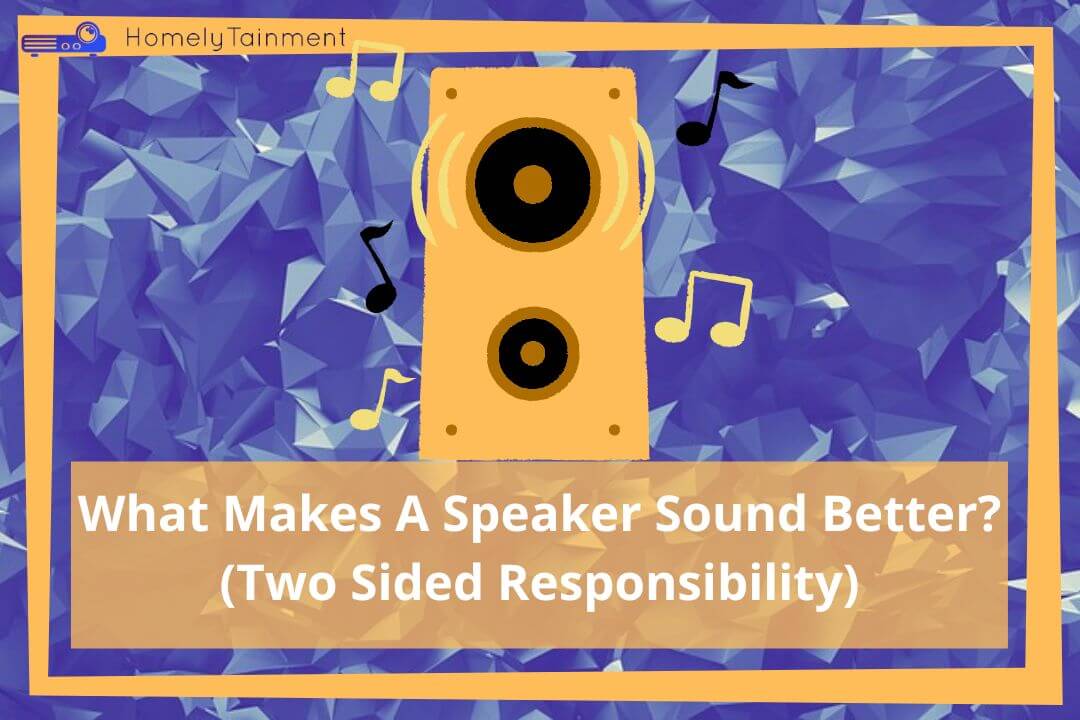
Homelytainment earn commissions (at no additional cost to you) if you purchase products from retailers after clicking on a link from our site.
The speaker’s sound quality is the backbone of an optimal home theater experience. There are many things and angles responsible for their good quality sound.
But don’t worry you are not alone responsible for its performance, but the manufacturers are equally responsible.
Read this article completely to know why you and the brand both are responsible for speakers’ quality.
What Makes A Speaker Sound Better? At A Glance:
- Speaker’s Cabinet Build Quality Affect The Sound
- Speaker Driver’s Build Quality Affect The Sound
- Supplied Power Decide The Sound Quality
- Supplied Data Signals Decide The Sound Quality
- Preamp Presence Decide The Sound Quality
- Placement and Position Decide The Sound Quality
- Theater Room Acoustics Decide The Sound
- Sound Calibration Decide the Sound Quality
- Speaker Wire Affects The Sound Quality
- Connectivity Method Decide The Sound Quality
Speaker’s Cabinet Build Quality Affect The Sound
The cabinet plays a vital role in making or breaking the sound quality. There are two angles to this point here.
One is how the cabinet is built, and another is from which material it is made.
The cabinet needs to be sturdy, and every screw should be screwed very well. The cabinet joints should be vibration resistant. When the sound, energy pumps in the cabinet should not resonate with it and produce separate vibration sounds.
This vibration sound along with the audio playing will deliver an unpleasant experience. And according to my experience, the speaker’s cabinet should not have any holes in it. When it is airtight it will keep the speaker’s driver’s movement in control. It will help the driver to produce clean and accurate sound frequencies.
That’s why I am not a fan of ported speakers. I am ok with a ported subwoofer, but not a ported speaker. You can read this guide, home theater ported vs sealed subwoofer to know more. I have tested both of them in this guide.
Let’s start with the material. The cabinet should be made of enough density material that can absorb the sound energy and not resonate with it. Again we are talking about resonance because it is very important.
Well, good density wood like MDF or HDF is the best candidate for it. They can refine the sound and will allow a clean sound to hit your ears.
That’s why confirm the density before buying a speaker, but this part is taken care of by the manufacturers.
Speaker Driver’s Build Quality Affect The Sound
The driver of the speaker seems simple, but it is not. There are many more small and big things in its composition, and each one plays a vital role in the sound quality.
The cone is supported by a surround which gives elasticity to the cone. They are backed by the spider. The spider keeps the cone in control. This spider is followed by a coil and magnet.
The coil material plays its role. The coil can be made of tin, copper, or any other material picked by manufacturers. This does impact the sound.
What material of the magnet made up of? That’s why I recommend buying speakers from the same brand and the same series. It will ensure the best matching and sound of the speakers.
This was the first tip. Another tip will be to look for Polypropylene cones. As this is the only visible part of the driver, and you can actually touch it. This material can provide sound with less possible distortion. No material has zero distortion, but polypropylene can provide less possibility.
These were the characters that impact sound, for which the manufacturers are responsible. The following are the steps that you are responsible for as a home theater owner.
Supplied Power Decide The Sound Quality
The supplied power to the speakers by amp or receiver orchestrates the sound quality. That’s why you should always match the speakers with the amplifier.
If you overpower or underpower them. In both cases, the sound will not be good, and you will shorten the lifespan of the speakers.
In an underpowered case, you will hear pop sounds, and the speakers will cut out gradually. In the overpowering case, the sound will not be good, and you will blow the speaker.
I have articulated both of these scenarios in these guides and have stated the solutions too. I don’t want to repeat the same stuff here because it will make a skyscraper from this guide.
How to match the amp to the speakers? &. Why are speakers cut out at high volume? Read these guides, and you will know why power is significant.
Supplied Data Signals Decide The Sound Quality
The signals originating from media sources need to be polished before they are pushed to the amplifier.
If pushed, the raw signals to the amplifier, and then they are pushed to the speakers. The speakers will fatigue quickly, and you will not get a fuller and richer sound. The speakers’ lifespan will also be shortened.
So what to do to have fuller, richer, and deeper sound? Read the following to know.
Preamp Presence Decide The Sound Quality
The preamp takes a low level of signals from the media source and works on it. Make it digestible for the amplifier.
The amplifier easily amplifies them and transfers them over to the speakers. The speakers output them better with no distortion. The sound feels richer and the speakers’ lifespan is also prolonged.
Well here is another question. Is the preamp necessary? No, it is not necessary, but it can give an unimaginable sound. Those can’t imagine the richness of sound that has an amplifier without a preamp in the chain.
I have answered a few more questions about preamp in this guide. Why use a preamp and power amp together?
Placement and Position Decide The Sound Quality
Where you have placed the speaker and how they are positioned in the home theater have a huge impact on the overall sound quality.
You should have all the speakers all around you and should not sit only at the front. This will ensure an immersive sound. The speaker tweeter should be positioned in a way that it is pointed at your ear, and it should be placed at a height that matches the height of your ear level.
However, not every speaker should be at ear level. I have articulated this in detail in this guide. How high to mount each speaker in the surround sound? You will know the height value for each speaker.
Also, You need the speakers to be 6 inches or 1 foot away from the wall. But not wall mount speakers, as they are engineered differently. I have articulated this in detail in this guide. Can you mount regular speakers? You will know the engineering behind it.
Theater Room Acoustics Decide The Sound
You need to treat the acoustics of your home theater.
You need to stop the sound reverberation in the room. This will ensure that you hear one dialogue once and not multiple times over and over again with microseconds of delay between the repetition.
You need to install acoustic panels in the room. Read my guide to know every detail of installing them. How to install acoustic panels?
After this, you need to soundproof the room. You don’t need the outside sound to travel inside and inside to outside. Read my this guide on soundproofing the theater rooms. You will get the whole process on a silver platter.
Sound Calibration Decide the Sound Quality
The receiver needs to know the acoustic environment of the room properly. For that, you need to calibrate the sound of the speakers with the help of a calibration mic.
These mics are provided with the receiver. If it is not provided, then you can buy it for yourself.
These mics and software can be provided by Dirac or Sonarworks.
The Dirac software is very robust and helps very well in calibrating the sound.
After calibrating the sound, the receiver will better know your needs. This will improve the sound for you.
Speaker Wire Affects The Sound Quality
The length and width of the wire affect the sound quality. The length contributes to impedance and the impedance directly hit the sound quality as the speaker doesn’t get enough power due to it.
That’s why if your speakers are away from the receiver, then you should use bigger-width wires.
The bigger, the better, but I have articulated this matter in detail in this guide.
Which gauge wire for bookshelf speakers? This guide is for every type of speaker, not just a bookshelf. Don’t forget to download the recommended gauge chart at the bottom of the article.
Connectivity Method Decide The Sound Quality
Did you connect the TV or media sources to the receiver via Bluetooth, HDMI, or optical? They all affect the sound.
For the best quality sound possible, you need to connect the media source to the receiver with a high-quality HDMI cable. HDMI cables have the highest bitrate which means they can carry bigger data with no lip-sync issues.
Also, HDMI eARC provides many more cool features such as HDMI CEC.
Check This future-proof 8K HDMI cable on Amazon. It will be useful for the years to come.
Did you get something out of this speaker guide? Hold On We Have Something Exciting To Share.
[the_ad id=”4771″]FAQs
What makes a speaker sound bright?
It will happen due to two ways. Either the tweeter is poorly engineered or you are using silver wire. Try to use the copper wire for the speakers’ connectivity to check if the brightness has gone.
What makes a speaker sound warm?
It will happen due to things. Either the subwoofer is designed poorly or you are setting all the speakers to (large) in the audio settings. Try to set the speakers to small to check if the warmth has gone.
When you compel the speakers to play bass frequencies, and they are not designed to handle them, they will sound warm. That’s why set them to small and divert all the bass frequencies to the subwoofer.
How do I make my bass sound fuller?
Have the best quality subwoofer and introduce the preamp to the chain to have fuller bass and overall sound.
The preamp refines the sound signals, which can further give you fuller bass down the road.
Helpful Resources For The FAQs To Read More
- This was my opinion, read more about it on the Audiogon forum. (Resource for the first answer)
- This was my opinion, read more about it from the Talkbass forum. (Resource for the third answer)




